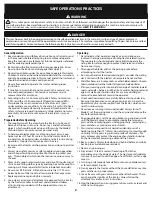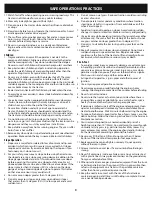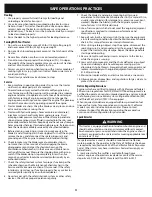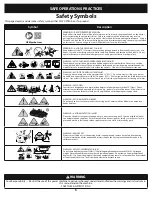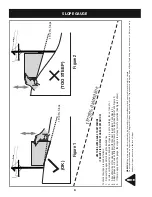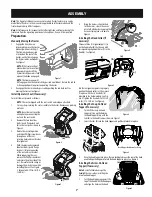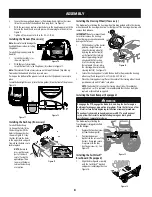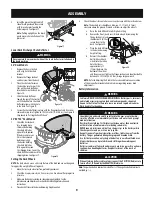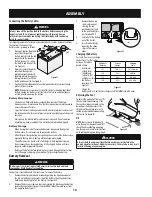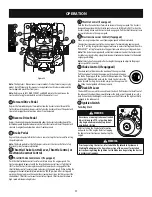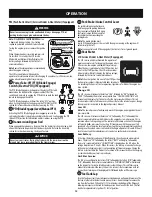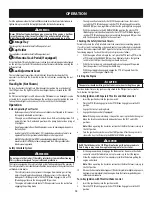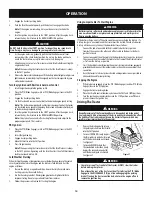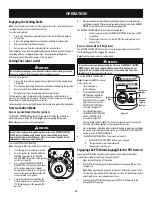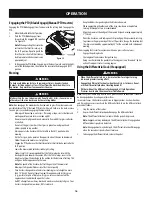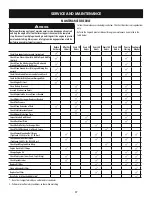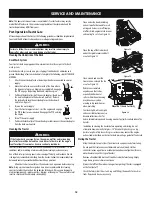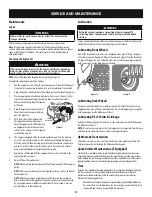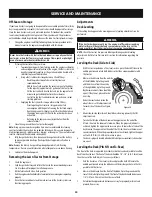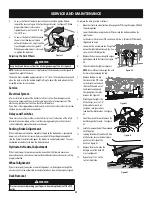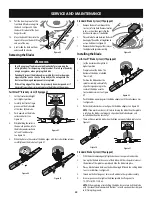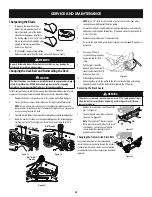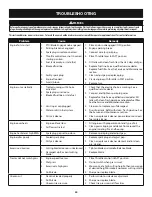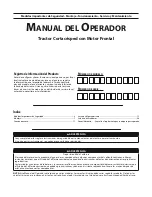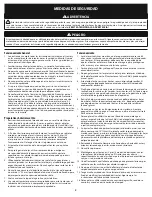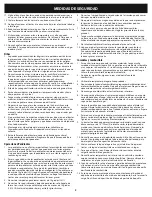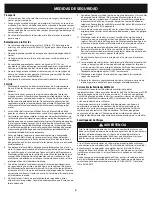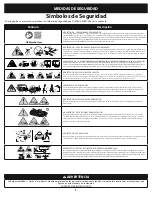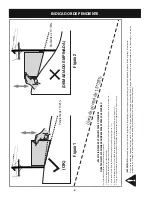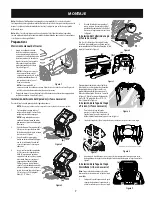
16
OPERATION
Engaging the PTO (Blade Engage)(Manual PTO tractors)
Engaging the PTO (Blade Engage) transfers power to the cutting deck. To engage the
PTO:
1.
Move the throttle to the FAST position.
2.
Push the PTO (Blade Engage) lever
forward into the engaged (ON) position.
See Figure 30.
Note:
When operating the tractor be
certain that the throttle is always in
the FAST position. Operating with the
throttle at less than full throttle may
lead to premature battery wear and a
poor quality cut.
3.
To disengage the PTO (Blade Engage), push the lever forward and to the right,
out of the locked position, then release the lever into the disengaged (OFF)
position.
Mowing
WARNING
To help avoid blade contact or a thrown object injury, keep bystanders,
helpers, children and pets at least 75 feet from the machine while it is in
operation. Stop machine if anyone enters the area.
WARNING
Make certain the area to be mowed is free of debris, sticks, stones, wire or
other objects that can be thrown by the rotating blades.
Note:
Do not engage the mower deck when lowered in grass. Premature wear and
possible failure of the “V” belt and PTO clutch will result. Fully raise the deck or move
to a non grassy area before engaging the mower deck.
•
Mow up and down slopes, not across. If mowing a slope, start at bottom and
work upward to ensure turns are made uphill.
•
Do not mow at high ground speed, especially if a mulch kit or grass collector
is installed.
•
Do not cut the grass too short. Short grass is prone to weed growth and
yellows quickly in dry weather.
•
Always operate the tractor with the throttle in the FAST position while
mowing.
•
On the first pass, pick a point on the opposite side of the area to be mowed.
Follow the point to maintain a straight line.
•
Engage the PTO and move the throttle control or throttle/choke control to the
FAST position.
•
Lower the mower deck to the desired height setting.
•
For best results it is recommended that the first two laps be cut with the
discharge thrown towards the center. After the first two laps, reverse the
direction to throw the discharge to the outside for the balance of cutting. This
will give a better appearance to the lawn.
Note:
The speed of the tractor will affect the quality of the mower cut.
Mowing at full speed will adversely affect the cut quality.
•
Your tractor is designed to cut normal residential grass of a height no more
than 10” (25cm). Do not attempt to mow through unusually tall, dry grass
(e.g., pasture) or piles of dry leaves. Dry grass or leaves may contact the
engine exhaust and/or build up on the tractor.
•
Do NOT attempt to mow heavy brush and weeds or extremely tall grass. Your
tractor is designed to mow lawns, NOT clear brush.
Figure 30
•
Keep the blades sharp and replace the blades when worn.
•
When approaching the other end of the strip, slow down or stop before
turning. A three point turn is recommended.
•
Align the mower with an edge of the mowed strip and overlap approximately
3” (7.6 cm).
•
Direct the tractor on each subsequent strip to align with a previously cut strip.
•
To prevent rutting or grooving of the turf, if possible, change the direction that
the strips are mowed by approximately 45° for the next and each subsequent
mowing.
When stopping the tractor for any reason while on a grass surface, always:
•
Engage the parking brake
•
Shut engine off and remove the ignition key.
•
Doing so will minimize the possibility of having your lawn ‘‘browned’’ by hot
exhaust from your tractor’s running engine.
Using the Differential Lock (If equipped)
WARNING
• When the differential lock is on, be sure to allow for a larger turning
radius and greater steering effort.
• Engage the differential lock only when the vehicle is stationary. Do not
use the differential lock when traveling downhill.
• With or without the differential lock engaged, all Safe Operations
Practices described in this manual must be followed.
Note:
The system should only be used when poor traction is encountered. It should
be disengaged when traveling on solid surfaces.
In some instances, the tractor may be driven in slippery or low-traction situations
and it may be necessary to activate the differential lock. To use the differential lock
proceed as follows.
1.
Stop the motion of the tractor.
2.
Depress the differential lock pedal to engage the differential lock.
Note:
The differential lock only works while the pedal is depressed.
Note:
Engagement may be delayed. The differential lock will engage when
different wheel speeds are detected.
Note:
Disengagement may be delayed. The differential lock will disengage
when the rear wheel speeds allow it to release.
3.
To disengage the differential lock, release the pedal.

